I had wanted to catch Asteroid (18024) Dodson which is named for the inventor of what are now known as Dobsonian reflectors who died January 15, 2014 at age 98 but weather didn't cooperate. I finally settled on getting it through some sucker holes. The asteroid naming citation sums up Dobson's contribution to amateur astronomy saying: "John Dobson (b. 1915) is one of the most important popularizers of astronomy of the twentieth century. His telescope design has spread around the world and enabled amateur astronomers to use larger apertures than before. He demonstrates a passion for sharing his knowledge of the universe with the public at large."
While he could have made a fortune selling rights to the mount to commercial telescope makers he intentionally made it freely available to all. While he held some rather odd ideas about the universe he loved showing the universe to the public. A good article on him is at http://www.skyandtelescope.com/astronomy-news/john-dobson-19152014/ . Be sure to catch the video mentioned ( http://www.youtube.com/watch?v=oJCN4HEXDqE ) as he talks about some of his rather unorthodox views of cosmology. I suspect they were heavily influenced by his Vedantan monk philosophy.
My weather here has been awful this winter. Conditions were poor the night I captured this image. At an estimated magnitude 19.4 it showed rather faintly in my 10" framing image. When the data came in that object didn't appear to move but a "star" about 5 minutes to the north was moving slightly. I thought it odd the minor planet center so missed its orbit. Normally it is dead on with well-known asteroids like this. It wasn't until I processed the image I saw the object I thought was asteroid Dobson was indeed the asteroid. The moving star was a different, brighter, asteroid that was trying to steal the image from Dobson. Neither is moving very fast. Both are nearing the end of their retrograde motion thus are rather stationary in the sky. Dobson moved only a bit under 6" of arc during the luminosity frames while the scene stealer moved a bit over twice as far. Its designation is (29723) 1999 AD24 and is listed at magnitude 18.8.
The asteroid is in eastern Taurus not far from Orion's shield. This area is poor in DSO objects. While a few galaxies in the field are listed at NED they have no information on distance, size, magnitude etc. The few they have are from the 2 micron survey and identified only by position. So I made no effort to annotate them. But I have included an annotated image as finding Dobson's nearly star-like asteroid is difficult without having it pointed out. I originally planned on making a movie of the asteroid moving through space but its motion is so slight that's not possible given my poor conditions here. I couldn't even get a second round of color due to the sucker hole closing completely.
14" LX200R@ f/10, L=4x10' RGB=1x10', STL-11000XM, Paramount ME | 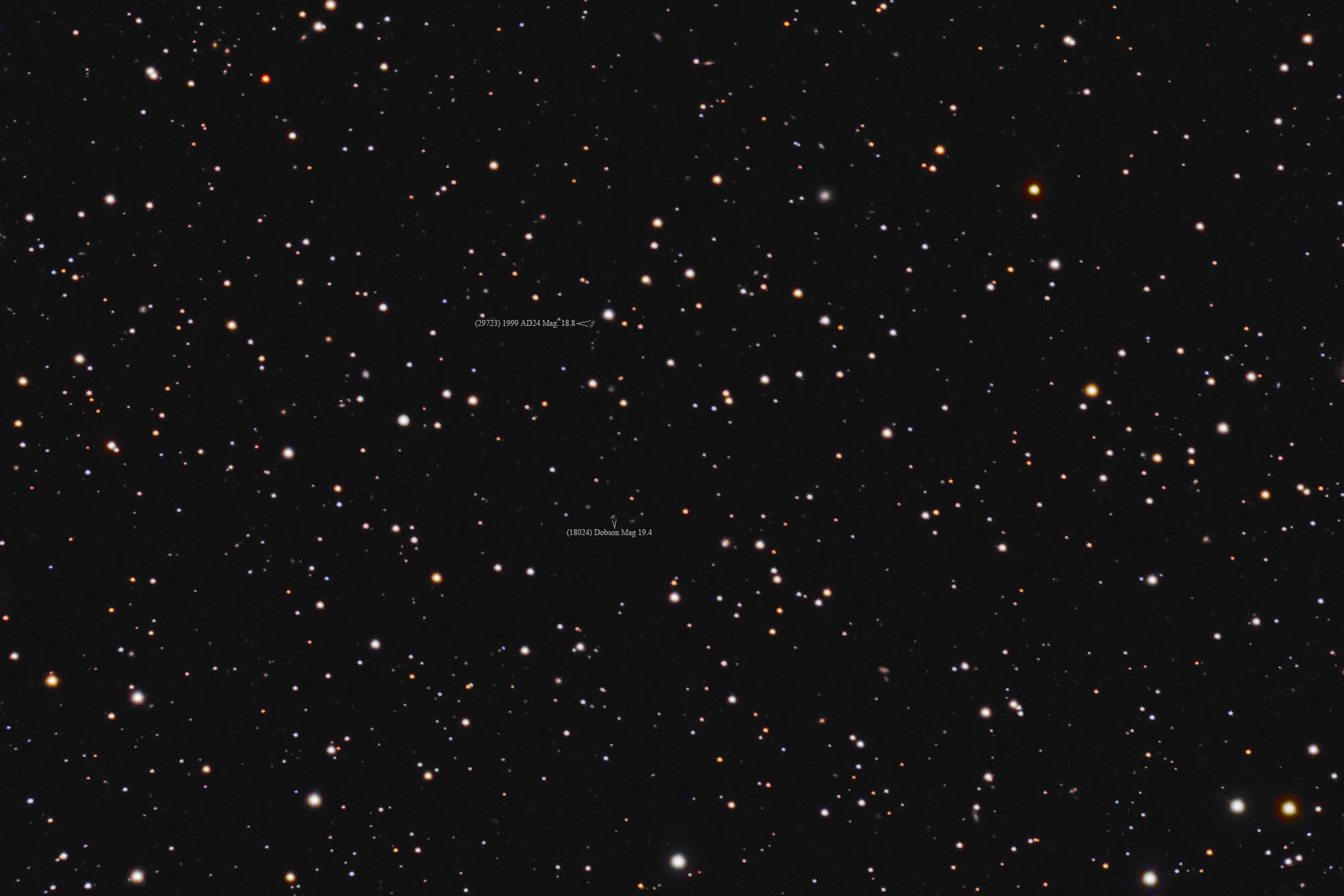
DOBSONL4X10RGB1X10-ID.JPG

DOBSONL4X10RGB1X10.JPG
| On May 31 at 20:59 UT asteroid (285263) 1998 QE2 passed within about 3.6 million miles of the Earth. It was daylight here and the asteroid below my horizon. That night it never got high enough to clear the walls of the observatory and it was cloudy with light rain in any case. The weather did clear on June 2, 2013 about 8:30 UT but by then the asteroid was in my Meridian tree and it was dawn before it came out. The following night we had broken clouds. It was high enough but looking low I was seeing too many clouds for decent images. Still, I had to try as the forecast (and actual weather) was for rain and clouds since then. I did manage 15 1 minute frames while tracking on the asteroid. Conditions varied greatly making this a processing nightmare that has taken me several long days to sort of make work. The clouds moved in during the 15th frame and totally hid the sky for a while putting an end to the movie which covers the time from 05:41 through 05:58 on June 3, 2013, UT.
After it "cleared" I had just time to grab three 10 minute frames in RGB for a starfield shot with the asteroid making a very long colorful trail. I assembled these into an RGB image of the stars and cloned out the asteroid but noted its position precisely at the start of this series. Clouds covered the frames more than it was clear so they are about equal to 3 minutes of color in clear skies but was the best I could do. I then aligned the asteroid trails using the brightest (most cloud-free) section of each trail. This gave me the RGB values for the asteroid which came out rather white with a slight reddish slant. It is said to be virtually black reflecting only 4% of the light it receives. I have no idea if my color is reasonable or not. Just what I got. I then stacked the 15 luminance frames of the movie to get an image of the asteroid and applied the RGB values I obtained from the color frames. I then put this image of the asteroid in the carefully noted position it was in when I first started the color frames. The color image is the result of this process.
Even with so little light, I was surprised to see another asteroid in the frame. One out in the asteroid belt. Since I was tracking on the stars it made a short colorful trail in the image. It is (10176) Gaiavettori at magnitude 16.0. 1998 QE2 was at magnitude 11.4. These magnitudes are according to the minor planet center as my data is too poor to use.
Even more surprising was that I captured a galaxy that is on my to-do list! Unfortunately, it is still on the list as I had so little data it just shows as a faint reddish blob. It is a neat ring galaxy much like Hoag's object. If the rain ever lets up I'll try again for it. It is the bottom-most galaxy on the left side of the annotated image. NED had no distance data for it but did for the much fainter galaxy nearby. The image also contains two flat galaxies from the 2MASS Flat Galaxy Catalog. Few frames contain one by random luck. Two is very surprising. All galaxies in NED with redshift data are noted in the annotated image as are a few of the brighter ones without distance data. Far more were listed but my extremely limited data prevented me from seeing most of them.
Color frame data:
14" LX200R @ f/10, Field: RGB=1x10' (heavy clouds) 1998 QE2: L=15x1' RGB=1x10', STL-11000XM, Paramount ME Related Designations for 1998QE21998QE2, | Video: https://images.mantrapskies.com//catalog/OTHER/1998QE2/1998QE2.WMV 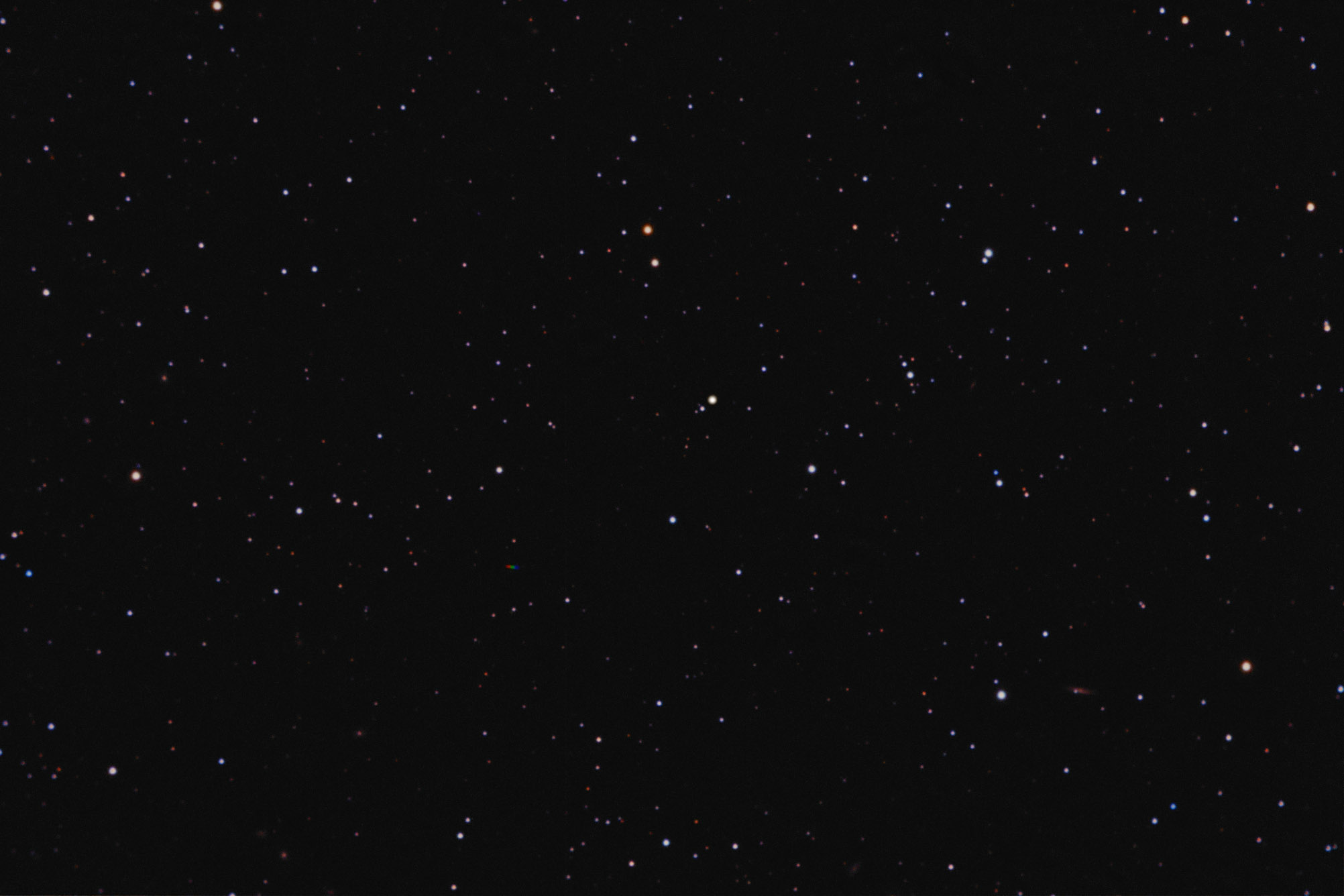
1998QE2RGB15X1RGB1X10.JPG
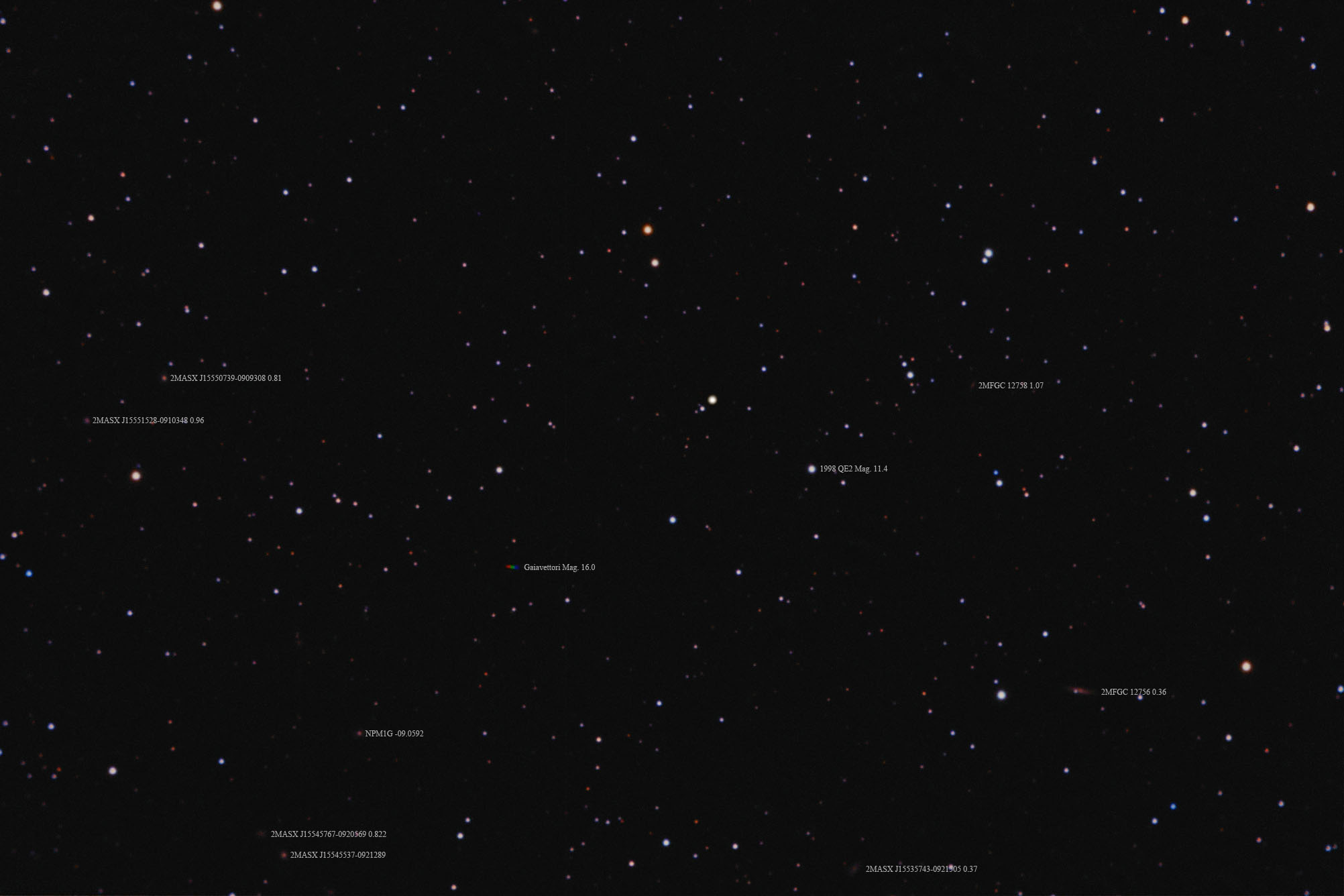
1998QE2RGB15X1RGB1X10ID.JPG
| (153591) 2001 SN263 made a close pass by the earth in February 2008. On February 15 I was able to catch it passing by in a series of 15 30 second exposures. It was about 6.5 million miles away at the time but moving rather rapidly, a bit over 7" of arc per minute. My USB1.1 camera is slow downloading so there's a noticeable gap between each frame. It was about 6.1 million miles away when, a few days later, Arecibo discovered it had two satellite asteroids. So instead of imaging one asteroid, it turns out I was taking three. The main asteroid is a bit under 3 kilometers in size while the satellites are .77 and .43 kilometers in size.
Only two other trinary main belt asteroids are known that I'm aware of; (136617) 1994 CC and 3122 Florence. They were found to be trinaries in 2009 and 2017. That makes this one the first trinary asteroid known.
Normally I'd not post such a basic image as this one but after learning its history and my image being taken just before it was discovered to be trinary I decided to include it.
14" LX200R @ f/10, L=15x30", STL-11000XM, Paramount ME | 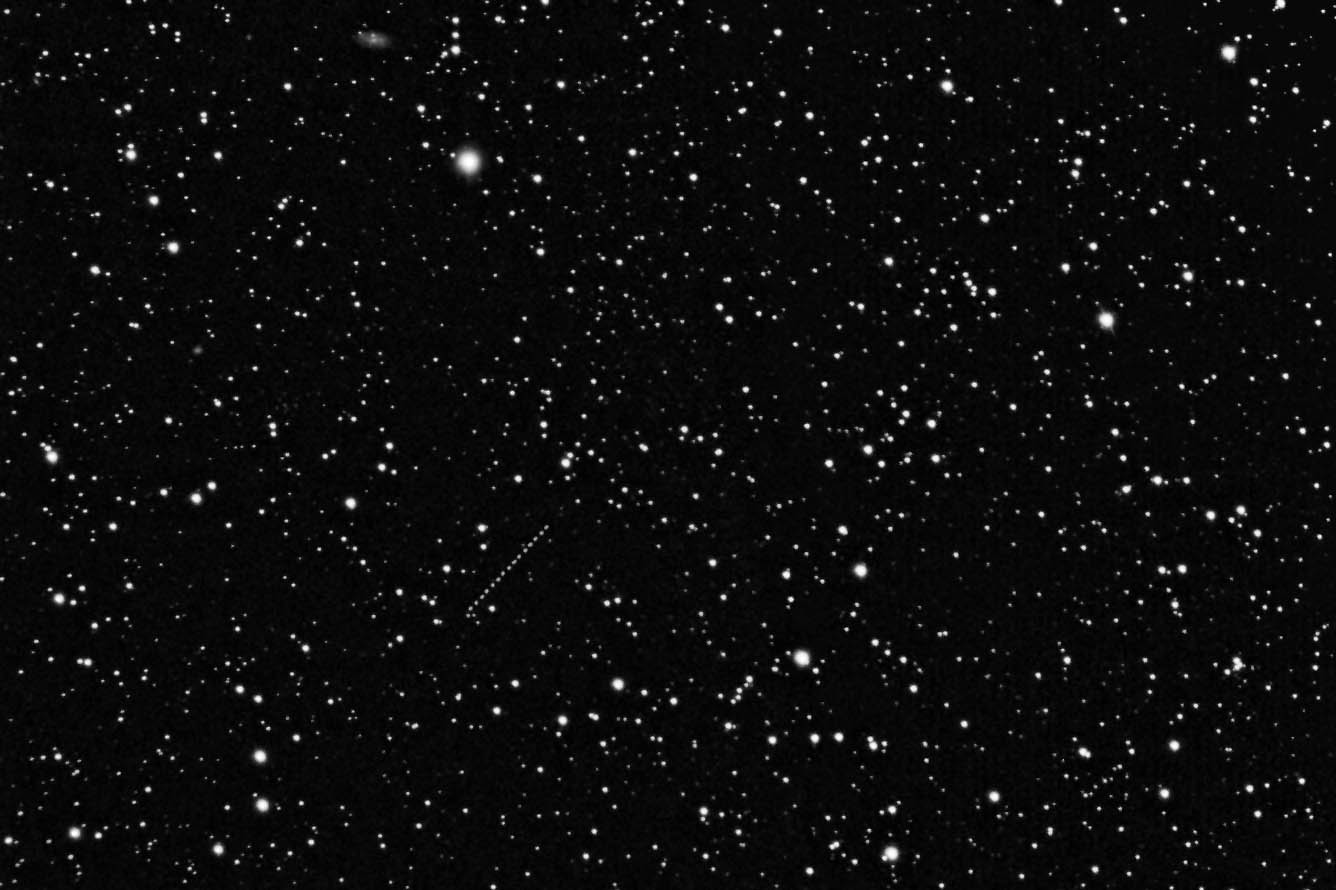
2001SN263L15X30.jpg
| (153958) 2002 AM31 is a NEO (Near Earth Asteroid) that got a lot of print a few days ago. It passed "close" to earth on July 22.99, 2012. That was daylight here and cloudy all night. The following night about 29 hours after closest approach it was only 1.2% further away or about 3,363,000 miles. Conditions still weren't great. I took 40 minutes of data of which the last 20 were usable though the first few frames were iffy and needed some work due to clouds. I made the 19 frames into a GIF animation each frame 1 minute long covering 20 minutes real time so you can see it is really moving. Each frame is one minute so the motion is 200 times actual speed. There are only 19 frames in the animation due to the time it takes my camera to download a frame adding the extra minute
Images were taken while the Paramount ME was tracking the predicted orbital path. There seems to be a slow drift north and I found it was not exactly where the elements I used (several days old) predicted. Likely due to changes in the orbit due to the close passage. Still, it tracked the asteroid well enough. I could have aligned the images but time was short so they were not aligned in any way. This is just the raw data from the camera using a one-quarter frame binned 3x3 using a simple linear histogram stretch. Only processing was dark subtraction. No flats were taken as not needed for such simple processing. Image scale would be 1.5" per pixel. Taken with my ordinary equipment, 14" LX200R @ f/10 and STL-11000XM. Each frame processed to about the same star and background intensity. Difficult due to rapidly changing conditions.
Slooh's coverage (40 minute video) of the "event" is at:
http://www.youtube.com/watch?v=JG9YzKlFDbo
Or you can watch my <7 second video. Related Designations for 2002AM312002AM31, | 
153958_2002_AM31.gif
| 2003DZ15 made a "close" pass by the Earth at the end of July 2013. That is, if you consider 2.1 million miles close. Unfortunately, it was cloudy that and the following night. The weather was poor the night before but I did manage to get 20 two minute frames through a semi-gap in the clouds. The asteroid was 90,000 miles further away but slightly brighter due to it moving toward the sun so we were seeing less of its sunlit side each night. The difference was only a tenth of a magnitude. When dealing with a 17th magnitude object that's not all that great a difference. Thanks to the clouds and haze between clouds it appears even fainter in my movie.
I used some rather harsh processing to try and make the star trails look rather even. In the raw data, they varied greatly in intensity as the obscuring clouds changed their brightness rather rapidly. I first normalized on the asteroid to keep it rather constant then selected the star trails for repair efforts. Only the brighter were worked on so the faint trails have lots of breaks. Fortunately, they go by fast enough my eyes don't notice this unless I stop on a frame. The asteroid was moving at 46.9 seconds of arc per minute. This, however, did change by about a half second of arc per minute during the 40 minute run. Since The Sky only tells the mount the orbital motion offset at the start of the run and that started about ten minutes before I began the movie run as I was waiting for clouds to clear, the asteroid does drift slightly during the movie. Note that south is up in this movie rather than my normal north up. The movie seemed more "natural" that way.
While it was taken at 1.5" (binned 3x3) per pixel I've reduced it to 3" per pixel for the movie to keep the file size reasonable. Though you can run it full screen and get a better view. It survives this enlargement surprisingly well thanks to the lack of any detail to be resolved. You might want to set your viewer to auto-repeat as it runs 40 minutes of time in 4 seconds.
14" LX200R @ f/10, 20x2'x3, STL-11000XM, Paramount ME Related Designations for 2003DZ152003DZ15, | Video: https://images.mantrapskies.com//catalog/OTHER/2003DZ15/2003DZ15R.wmv | 2005 YU55 made a near-earth pass on November 8,9, 2011. Closest approach was about 0 hour hence the two dates. It was three hours later that skies were clear enough for me to catch it. Even then I imaged through rather thick gunk making this a processing nightmare. The asteroid was under the neck of Pegasus (north of the neck as the horse is upside down in our skies) so getting a bit low. It was about 230,000 miles from us, about the same distance as the moon. As near earth asteroids go it is fairly large at an estimated size of 360 meters (1200 feet) across. While not currently considered a threat it could do real harm if its orbit changes enough to put it on a collision course. Most changes would move it further away, however. My movie is made of 10 fifteen second exposures. So you can see it was moving very rapidly. About 6.77" of arc per second of time. The image was taken at 1.5" per pixel so it was moving more than 4 pixels per second if I'd not had the mount compensating for its motion.
14" LX200R @ f/10, L=10x15", STL-11000XM, Paramount ME Related Designations for 2005YU552005YU55, | 
2005YU55.gif
| 2007 TU24 was making its closest approach to the earth, about 1.4 times further than the moon, when I took this image on January 27, 2008, two days before closest approach. With clouds forecast for the next few days, this was the best I could do. The asteroid was discovered on October 11, 2007. It is estimated to be 250 meters (820 feet) in diameter. It's not easy imaging such a small rock at over 350,000 miles. At the time internet trolls were creating web pages claiming it would rain down destruction on the earth. Somehow I missed this horrific event as did everyone else, including these trolls. My image is made from 10 one minute images tracking on the asteroid which was 16th magnitude. It apparently brightened to 10th magnitude (predictions say) but thanks to clouds I can't verify this.
14" LX200R @ f/10, L=10x1', STL-11000XM, Paramount ME Related Designations for 2007TU242007TU24, | 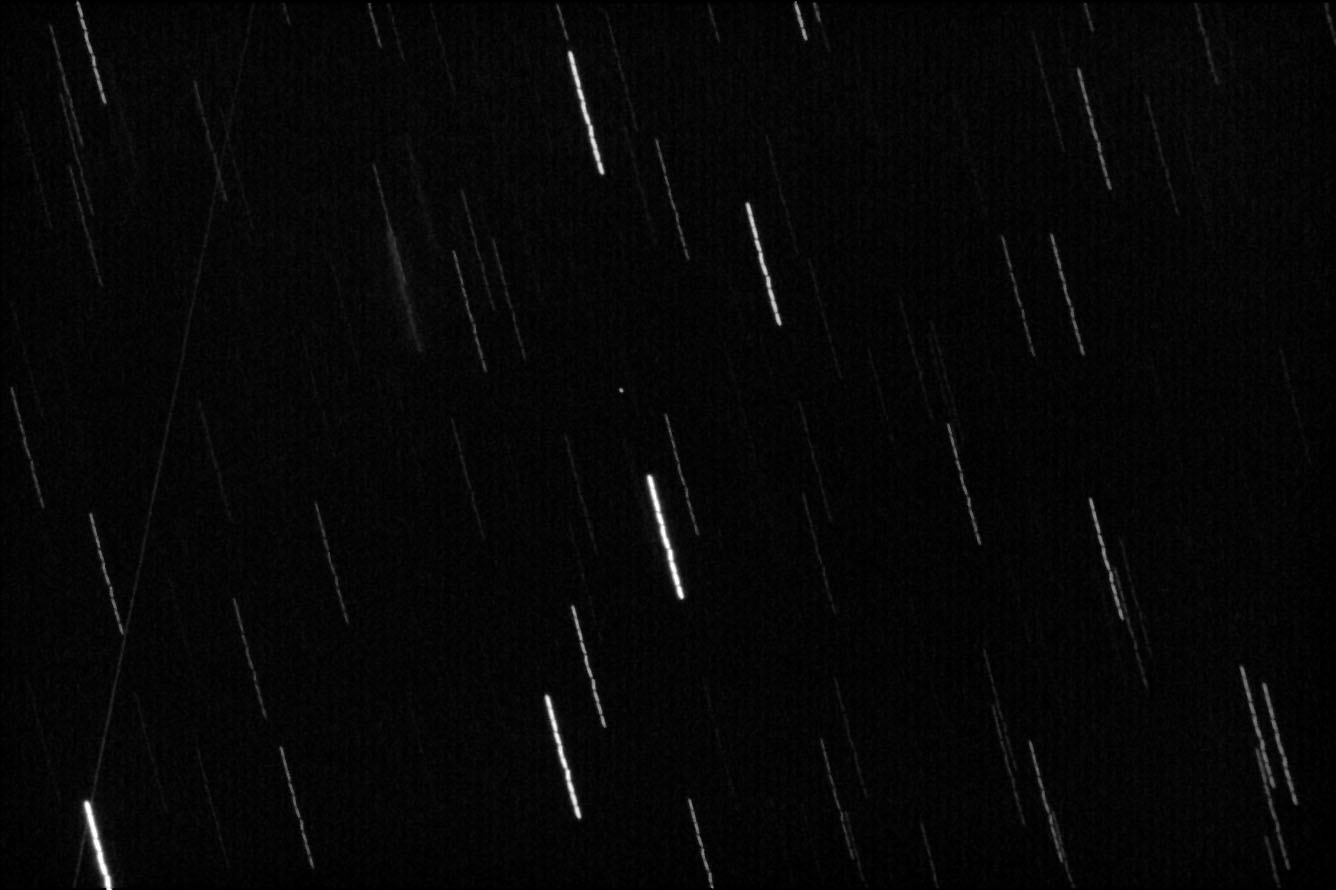
2007TU24-1X10.jpg
| 2008 AF3 was about 430,000 miles from earth when I made this image. It is thought to be about 19 meters in diameter. The image covers 11 minutes of time tracking on the asteroid taken at 1.5" per pixel. It was taken on January 15, 2008 at about 4 hours UT. Imaging such a small rock at such a great distance would seem to indicate it is more reflective than a typical asteroid.
14" LX200R @ f/10, L=10x1'x3, STL-11000XM, Paramount ME Related Designations for 2008AF32008AF3, | 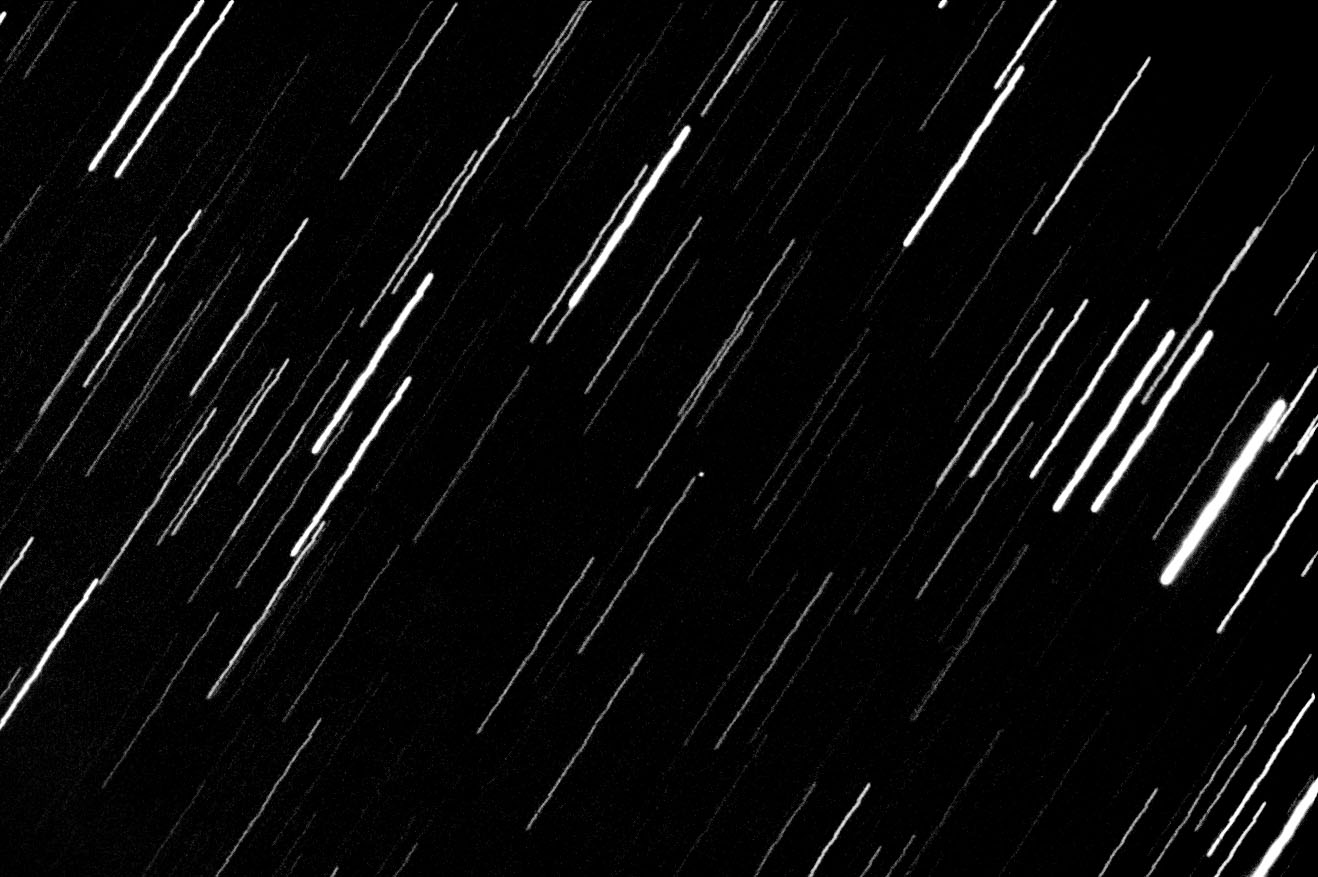
2008AF3-STOPPED10X1_1-15.444097-08.jpg
| http://www.mantrapskies.com/image-archive/OTHER/2010WC9SMALL/2010WC9small.HTML
http://www.mantrapskies.com/image-archive/OTHER/2010WC9SMALL/2010WC9small.mp4
http://www.mantrapskies.com/image-archive/OTHER/2010WC9SMALL/2010wc9small.wmv
__________________________________
2010 WC9 passed about 130,000 miles from the earth on May 15. At that time it was visible only in the southern skies. The best I could do was a day earlier when it was about 650,000 miles away. Unfortunately weather that night was awful. Lots of high clouds but it was the high winds, some gusting to 90 kph according to my weather station. Normally I'd not open on such a night as the danger of flying debris is high. But with only this one night to catch the asteroid I did give it a try with strong easterly winds. The scope is steady with north or south winds but east ones over 50 kph can be a problem. By the time it hit gusts of 90 kph the scope is no longer steady.
I ran for 30 minutes taking 1 minute exposures to keep star trails short, I'd have gone longer in good weather but the risk was high and it appeared the scope was bouncing around a bit. Winds were getting stronger so I closed the observatory. It didn't dawn on me I was using an exposure, temperature and binning that I had no calibration frames for. I went to process this a few days later but with no calibration frames, I had to put it off until I could get them. Then the weather turned too warm for me to get any until the night of July 2 when the evening temp hit 16C and I could just reach the temperature needed. I didn't get as many darks as I'd have liked as the temperature went up and I had to stop. I went with what I could get for darks and made this movie.
Yes, the asteroid does move a bit in the strong winds. The high clouds add to the background. I didn't take the time to remove the many gradients the clouds caused. The mount was tracking on the asteroid's orbital elements. No guiding was attempted.
Estimates of the asteroid's size ranged from 38 to 119 meters in size. Other sources say 60 to 130 meters, another the size of the statue of Liberty and yet another the size of a football field or stadium. Even at this late date, I don't find a better size estimate. I'd have thought radio telescopes would have been tracking it and gotten this pinned down but I can't find that that happened. If anyone knows a better value let me know.
This movie is made of 30 1 minute exposures. It covers about 35 minutes of time as my camera is only USB 1.1 so slow to download a frame compared to modern USB 2 and USB 3 cameras.
14" LX200R @ f/10 L=10x1' binned 3x3, STL-11000XM, Paramount ME
Rick
Related Designations for 2010WC92010WC9, | Video: https://images.mantrapskies.com//catalog/OTHER/2010WC9/2010WC9.mp4 Video: https://images.mantrapskies.com//catalog/OTHER/2010WC9/2010WC9small.mp4 Video: https://images.mantrapskies.com//catalog/OTHER/2010WC9/2010wc9small.wmv | Asteroid 2012 LZ1 taken 7 hours after closest passage to the earth on the morning of June 15. I had to wait until it was high enough in the sky from my location for a reasonably clear view. The movie covers 21 minutes of time in 20 one minute frames. It takes a few seconds to download each frame increasing the time slightly. It was discovered only 4 days prior to its closest approach. If it had been on a collision course even Bruce Willis wouldn't have had to time save those in its path. Fortunately, it missed my some 5.3 million miles. Not even a close one compared to others in recent history. Movie taken with a 14" F/10 LX200R scope on a Paramount ME tracking the asteroid without guiding. Image scale is 3.2" of arc per pixel. Related Designations for 2012LZ12012LZ1, | 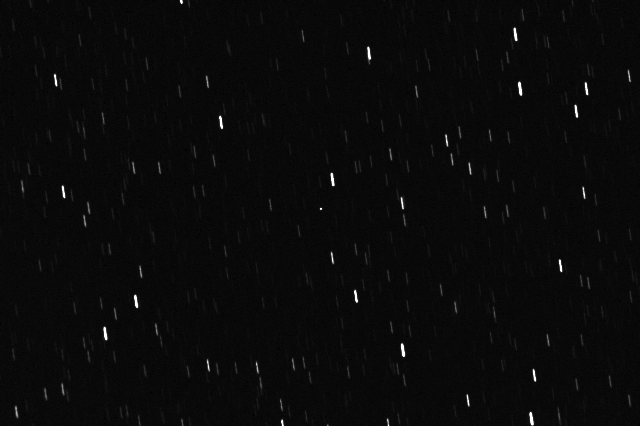
Asteroid_2012_LZ1.GIF
| 








